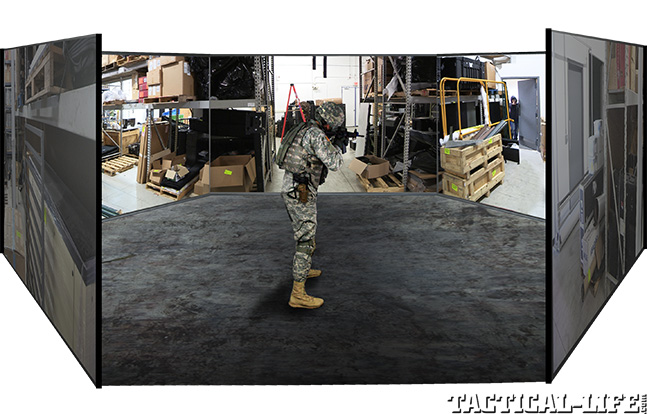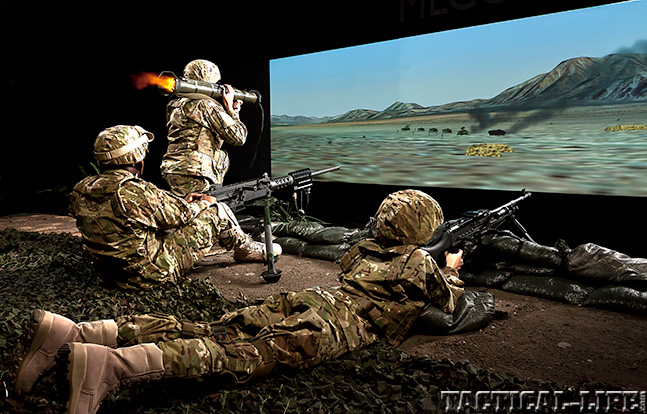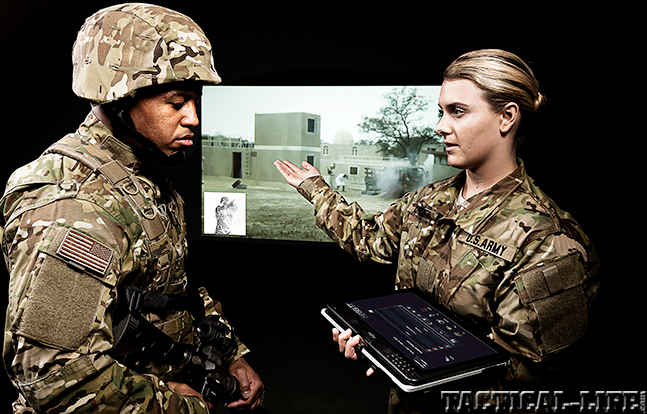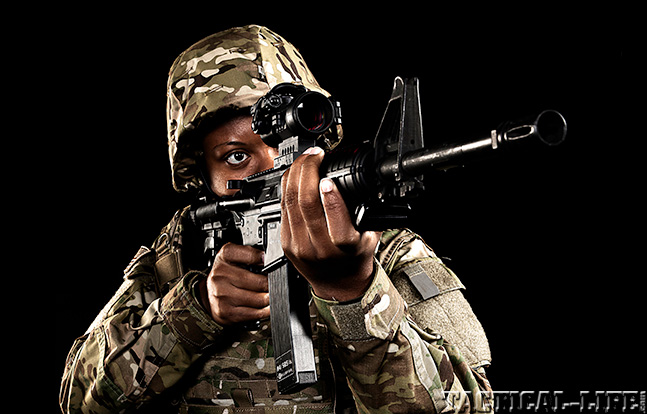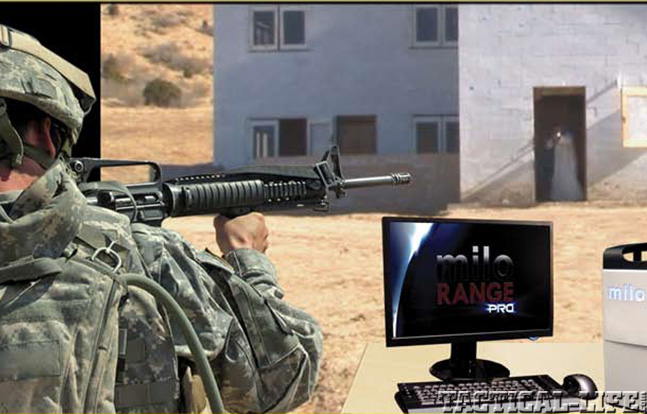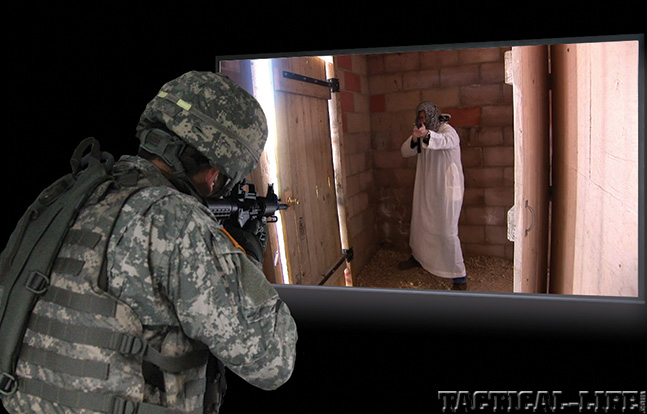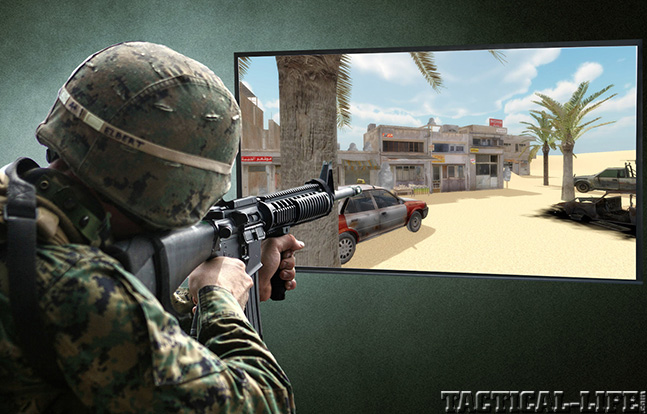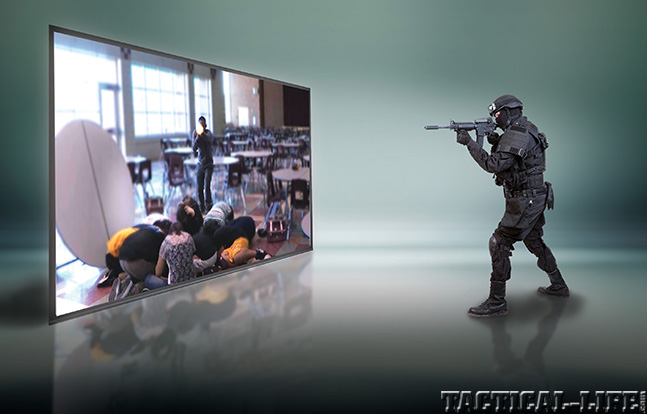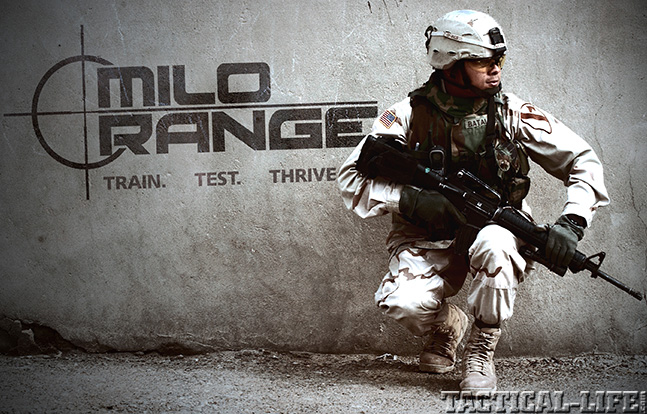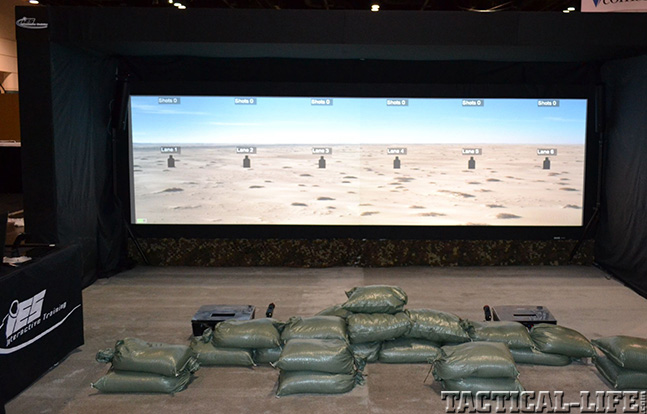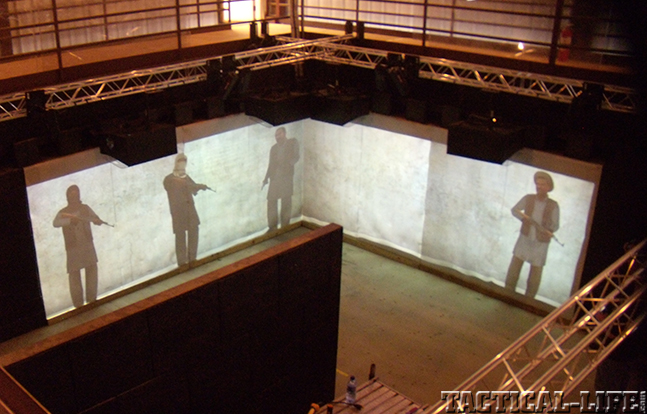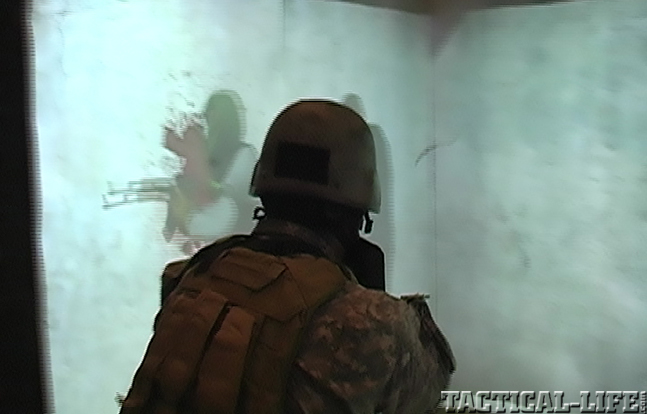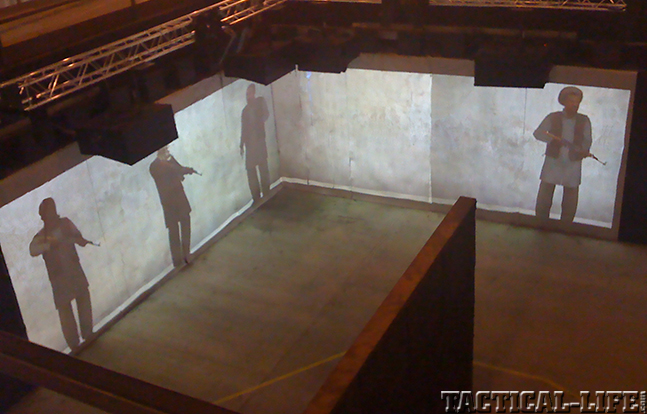Any firearms or tactical instructor will tell you that simulating realistic threats in a controlled and safe environment remains a daunting task. When we trained soldiers for “The Great War,” the doughboys shot at bullseyes. None of them were ever attacked by bullseyes on the battlefield and, subsequently, many found it difficult to shoot at real men during real battles. Nowadays, range targets look like human beings but typically appear stationary, non-reactive and far from realistic when compared to real enemy soldiers who are really trying to kill you. A handful of companies have integrated the latest technology to bring interactive, adaptive training to today’s men and women in uniform. Training simulators let soldiers experience, observe, interact and ultimately fight with lifelike, realistic opponents.
These shooting simulation systems have a few things in common. First, they use guns that fire infrared (IR) lasers at a screen. Some use dummy weapons, and some use converted real weapons. Some can simulate recoil by causing the bolt or slide to cycle, and others remain static. A special IR camera detects and records exactly where the laser hits the screen. The target on the screen is programmed to react when it gets “shot.” After the scenario ends, it can be played back, and a visible dot shows where the shot landed on the screen. These systems may sound like a video game, but they have a lot more in common with the holodeck on Star Trek than with Nintendo.
Meggitt Training Systems
Advertisement — Continue Reading Below
Started in 1984, Firearms Training Systems (FATS) is the original pioneer in this industry. These first systems played a movie on a screen, and when the participant shot the screen (which had to be repaired with tape each time) the projector would freeze. The old FATS M7 and newer FATS M100 are in use with U.S. military forces around the world. The systems are used to hone marksmanship and team training. Meggitt’s FATS M7 system is portable and quick to set up in virtually any room with a white screen or even a lightly colored wall. The FATS M100 has networking capabilities and is more adaptable. Costs for these systems range from under $40,000 to more than $100,000 and vary based on requirements, components, weapon simulators and accessories added to the system. The FATS M7 accommodates up to four trainees with eight total weapons. The FATS M100 accommodates up to 20 different weapons.
On top of that, all of the FATS systems can be used with Meggitt’s Hostile Fire System (HFS), which allows trainers to shoot foam projectiles back at the soldiers using the system. This added realism forces the trainees to constantly evaluate their use of cover, or walk away with a few new bruises. “Lookback” cameras record that soldiers as they are undergoing the training are also available. The trainer can show the trainee exactly what they did under stress. The camera doesn’t lie. The playback mode can even show exactly where soldiers were aiming on the screen throughout the entire scenario.
However, the main feature of FATS that sets it apart from its competitors is the fully sensored BlueFire weapon simulators. These start off as real guns but become much more. They are not tethered by any cord, but have “smart” magazines with compressed air that causes the weapon to cycle and recoil like a real weapon. They have Bluetooth so the instructor can control the weapon from up to 10 meters away. And, most impressive, the instructors can cause the weapon to run dry or malfunction. A click when you expect a bang is still the loudest sound in a gunfight. The fully sensored weapons also feed back real-time data to the instructor, including the trigger squeeze, butt pressure, weapon cant and more. As a firearms instructor, I would love to be able to cause these types of malfunctions during training to see how the trainee will react. Clearing malfunctions under stress will help them do it automatically when it happens on the battlefield.
Advertisement — Continue Reading Below
MILO Range
MILO Range has been designing and delivering small arms and use-of-force simulators since 1994. Used by every branch of our military, MILO systems are most heavily used by our Special Forces community. They are also used in more than 40 foreign countries and by a number of elite foreign counterparts.
MILO has a number of electronic shooting simulation programs ranging from small, portable units that can be set up and taken down in a few minutes to large, 300-degree environments that almost completely surround a soldier or group of soldiers and force them to constantly scan in all directions for possible emerging threats, just like in real life. Videos are in true HD, and the laser “hit” detectors can distinguish between 16 different weapons used simultaneously. Prices for these units range from approximately $12,000 to $115,000 for the multi-screen systems.
Advertisement — Continue Reading Below
What sets MILO apart from other shooting simulators is the use of the Windows interactive gaming Kinect system. Just like the Xbox, the MILO system uses Kinect to “see” exactly what the soldier is doing during training, and the targets on the screen are programmed to react accordingly. “Shoot” or “no shoot” used to be your only two options when confronted by a bad guy. Now, the Kinect can sense when the soldier throws a punch or a knee, swings a baton or ducks out of the way. If the soldier movers laterally, the entire viewpoint on the screen can shift accordingly. A straight-ahead view might show a pile of boxes, but if the trainee walks to the side, they may be able to see a foot of the bad guy hiding behind those boxes.
MILO is currently broadening its use of the Kinect system. Soon it will be able to recognize specific faces, voices, pick up on small hand gestures, and have the scenario on the screen react accordingly. Want to practice small team movements, assign someone a field of fire, or give commands to turn around and walk slowly toward the sound of your voice? MILO with Kinect can make all of that possible.
Laser Shot
Advertisement — Continue Reading Below
Incorporated in 1999, Laser Shot has long been known for its home systems and portable firearms safety training units. However, the company has also sold more than 1,500 training systems to military units worldwide. Besides supplying systems to every branch of our military and many special operations groups, Laser Shot systems are also used by military units globally.
Laser Shot can create live-fire and simulation shoothouses from scratch or retrofit existing structures. The Laser Shot Virtual Shoothouse, or LVS, is the heart of the system. A linkable, networking software system, it can be adapted to virtually environment. In an LVS, the projected images can fill one, two or even all of the walls. A life-sized bad guy can hide behind cover on Screen A, pop up, fire a few shots at you, and then run to cover on Screen B, shoot at you again, and then run down a hallway. If you shoot the bad guy in the arm, you’ll see blood and he’ll stop using it. Hit him in right spot, and he’ll drop in his tracks. The bad guy is programmed to use cover and to act intelligently. He can be exactly the same, or different, every time you go through, depending on what the controller tells him to do.
The LVS can be on one screen or on dozens throughout a building. Laser Shot’s weapons include recoil, non-recoil, inert, tethered and tetherless versions. Many of these LVS systems can also be used with live fire. The walls have to be constructed of special bullet-stopping materials and the screens have to be self-healing. Laser Shot’s patented Thermal SHOT technology actually tracks the real bullets fired and determines if and where it hit the bad guy on the screen, and it does so with sub-pixel accuracy. The truly amazing part: After the scenario is over, you can play it back at any speed and pause it to see where the bullet hit. Now let’s say it was a torso shot, but the bad guy kept running. Laser Shot’s Advanced After Action Review (AAR) can strip away the bad guy’s clothing and skin to show his musculoskeletal system and exactly what vital areas got hit or missed by the soldier’s rounds. Trainees aren’t just honing weapon skills and tactics—they are taking it to the next level, learning why their rounds did or did not drop their adversary.
Advertisement — Continue Reading Below
Close To Reality
The shooting simulators I first trained on in the 1990s have long been technologically surpassed by today’s home gaming systems. However, a few shooting simulation companies are pushing to make their training as close to reality as possible. They have developed software and systems so today’s soldier can be fully immersed into life-and-death scenarios where they’ll make mistakes, learn from them and develop advanced combat skills. A new soldier can safely gain valuable experience in a controlled environment before truly risking his or her life on the real battlefield.
Advertisement — Continue Reading Below
FOR MORE INFORMATION
Meggitt Training Systems
Advertisement — Continue Reading Below
MeggittTrainingSystems.com; 800-813-9046
MILO Range
MILOrange.com; 800-344-1707
Advertisement — Continue Reading Below
Laser Shot
LaserShot.com; 281-240-1122
